Change Management Report: Reducing Deficit at St. Joseph Hospital
VerifiedAdded on 2022/11/30
|14
|4246
|342
Report
AI Summary
This report provides a detailed analysis of change management strategies applicable to St. Joseph Hospital, focusing on addressing deficit issues. The report begins with an introduction to change management, emphasizing its importance in adapting to market conditions and achieving business goals. The main body of the report explores the communication of change, outlining essential steps such as identifying parties, stating reasons and benefits, presenting examples, and obtaining feedback. It also addresses the creation of a sense of urgency within the team to foster commitment and engagement, highlighting the importance of leadership in demonstrating commitment and sharing relevant data. Furthermore, the report applies the ADKAR model to ensure acceptance of change, minimizing resistance from employees and stakeholders. Finally, the report integrates Kotter's definition of leadership and management to develop a change management plan for reducing the deficit, suggesting tasks to reduce cost and waste while maintaining the quality of care. The report concludes with a summary of the key findings and recommendations.
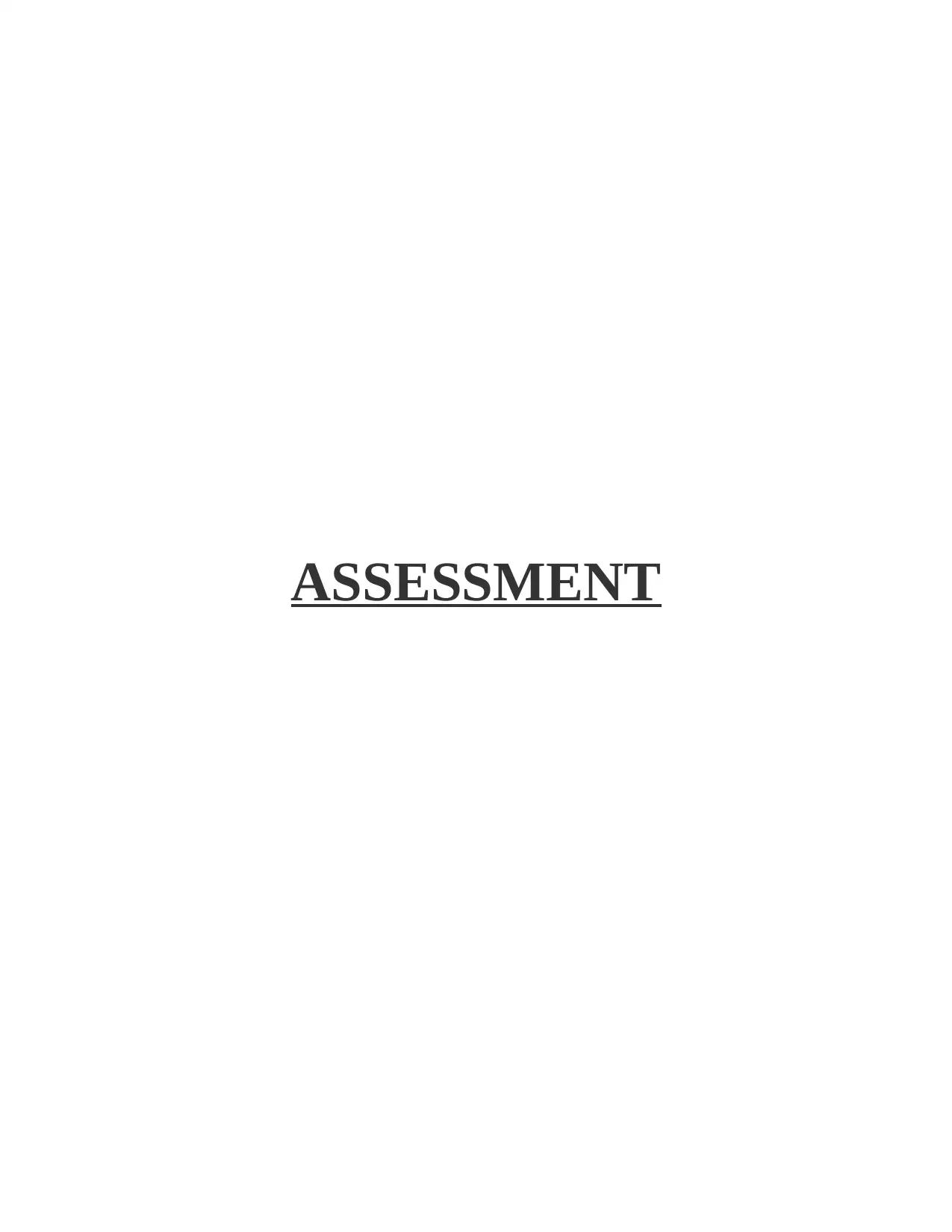
ASSESSMENT
Paraphrase This Document
Need a fresh take? Get an instant paraphrase of this document with our AI Paraphraser
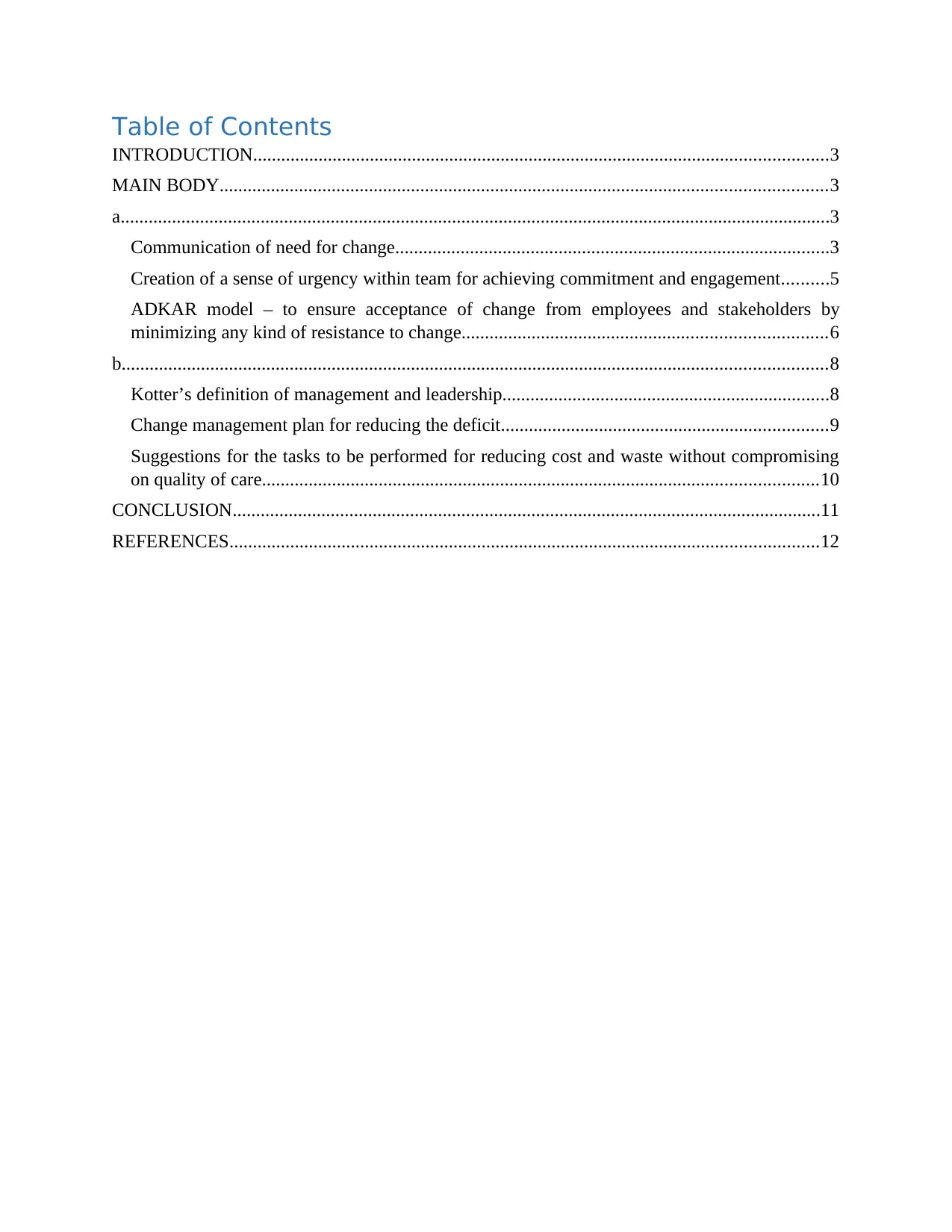
Table of Contents
INTRODUCTION...........................................................................................................................3
MAIN BODY..................................................................................................................................3
a........................................................................................................................................................3
Communication of need for change.............................................................................................3
Creation of a sense of urgency within team for achieving commitment and engagement..........5
ADKAR model – to ensure acceptance of change from employees and stakeholders by
minimizing any kind of resistance to change..............................................................................6
b.......................................................................................................................................................8
Kotter’s definition of management and leadership......................................................................8
Change management plan for reducing the deficit......................................................................9
Suggestions for the tasks to be performed for reducing cost and waste without compromising
on quality of care.......................................................................................................................10
CONCLUSION..............................................................................................................................11
REFERENCES..............................................................................................................................12
INTRODUCTION...........................................................................................................................3
MAIN BODY..................................................................................................................................3
a........................................................................................................................................................3
Communication of need for change.............................................................................................3
Creation of a sense of urgency within team for achieving commitment and engagement..........5
ADKAR model – to ensure acceptance of change from employees and stakeholders by
minimizing any kind of resistance to change..............................................................................6
b.......................................................................................................................................................8
Kotter’s definition of management and leadership......................................................................8
Change management plan for reducing the deficit......................................................................9
Suggestions for the tasks to be performed for reducing cost and waste without compromising
on quality of care.......................................................................................................................10
CONCLUSION..............................................................................................................................11
REFERENCES..............................................................................................................................12
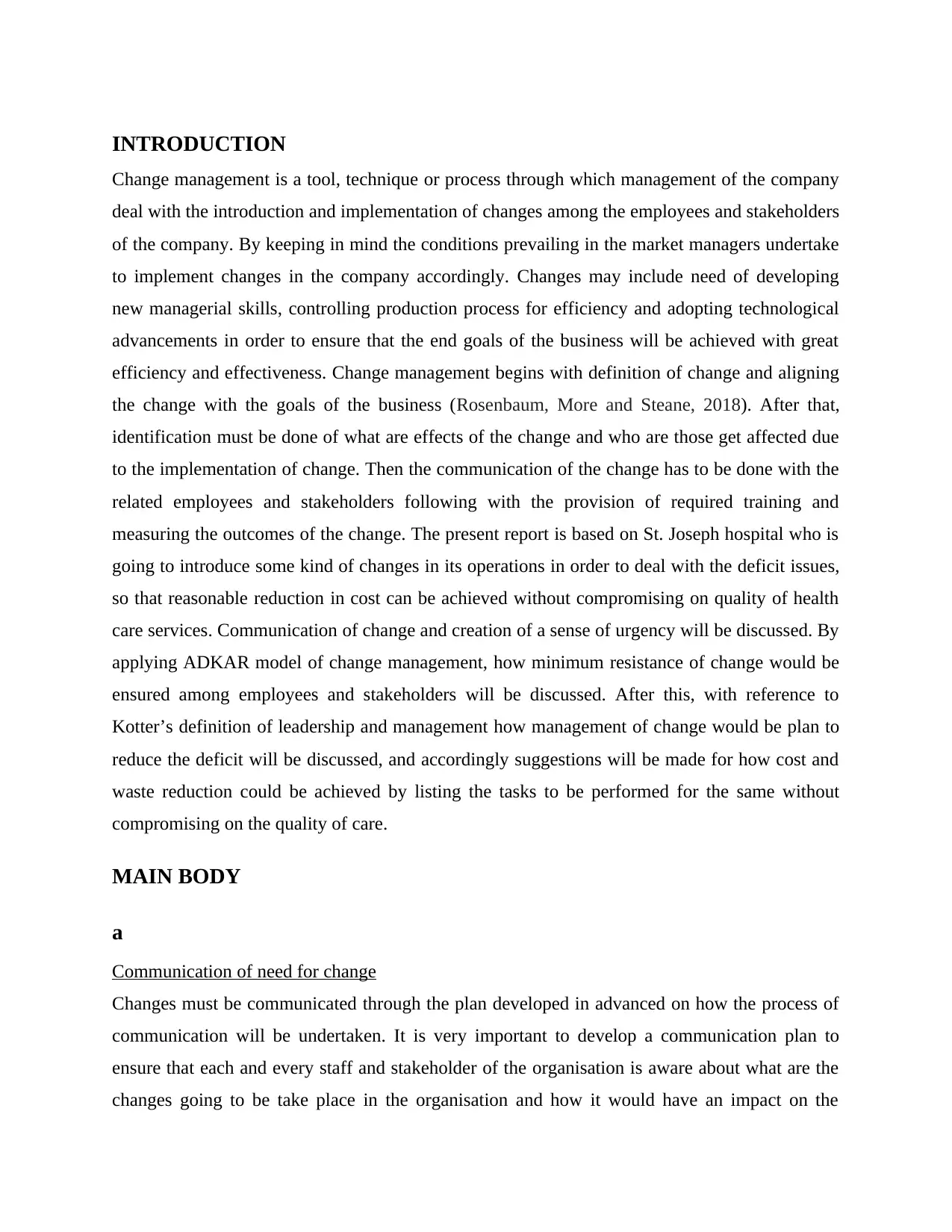
INTRODUCTION
Change management is a tool, technique or process through which management of the company
deal with the introduction and implementation of changes among the employees and stakeholders
of the company. By keeping in mind the conditions prevailing in the market managers undertake
to implement changes in the company accordingly. Changes may include need of developing
new managerial skills, controlling production process for efficiency and adopting technological
advancements in order to ensure that the end goals of the business will be achieved with great
efficiency and effectiveness. Change management begins with definition of change and aligning
the change with the goals of the business (Rosenbaum, More and Steane, 2018). After that,
identification must be done of what are effects of the change and who are those get affected due
to the implementation of change. Then the communication of the change has to be done with the
related employees and stakeholders following with the provision of required training and
measuring the outcomes of the change. The present report is based on St. Joseph hospital who is
going to introduce some kind of changes in its operations in order to deal with the deficit issues,
so that reasonable reduction in cost can be achieved without compromising on quality of health
care services. Communication of change and creation of a sense of urgency will be discussed. By
applying ADKAR model of change management, how minimum resistance of change would be
ensured among employees and stakeholders will be discussed. After this, with reference to
Kotter’s definition of leadership and management how management of change would be plan to
reduce the deficit will be discussed, and accordingly suggestions will be made for how cost and
waste reduction could be achieved by listing the tasks to be performed for the same without
compromising on the quality of care.
MAIN BODY
a
Communication of need for change
Changes must be communicated through the plan developed in advanced on how the process of
communication will be undertaken. It is very important to develop a communication plan to
ensure that each and every staff and stakeholder of the organisation is aware about what are the
changes going to be take place in the organisation and how it would have an impact on the
Change management is a tool, technique or process through which management of the company
deal with the introduction and implementation of changes among the employees and stakeholders
of the company. By keeping in mind the conditions prevailing in the market managers undertake
to implement changes in the company accordingly. Changes may include need of developing
new managerial skills, controlling production process for efficiency and adopting technological
advancements in order to ensure that the end goals of the business will be achieved with great
efficiency and effectiveness. Change management begins with definition of change and aligning
the change with the goals of the business (Rosenbaum, More and Steane, 2018). After that,
identification must be done of what are effects of the change and who are those get affected due
to the implementation of change. Then the communication of the change has to be done with the
related employees and stakeholders following with the provision of required training and
measuring the outcomes of the change. The present report is based on St. Joseph hospital who is
going to introduce some kind of changes in its operations in order to deal with the deficit issues,
so that reasonable reduction in cost can be achieved without compromising on quality of health
care services. Communication of change and creation of a sense of urgency will be discussed. By
applying ADKAR model of change management, how minimum resistance of change would be
ensured among employees and stakeholders will be discussed. After this, with reference to
Kotter’s definition of leadership and management how management of change would be plan to
reduce the deficit will be discussed, and accordingly suggestions will be made for how cost and
waste reduction could be achieved by listing the tasks to be performed for the same without
compromising on the quality of care.
MAIN BODY
a
Communication of need for change
Changes must be communicated through the plan developed in advanced on how the process of
communication will be undertaken. It is very important to develop a communication plan to
ensure that each and every staff and stakeholder of the organisation is aware about what are the
changes going to be take place in the organisation and how it would have an impact on the
⊘ This is a preview!⊘
Do you want full access?
Subscribe today to unlock all pages.

Trusted by 1+ million students worldwide
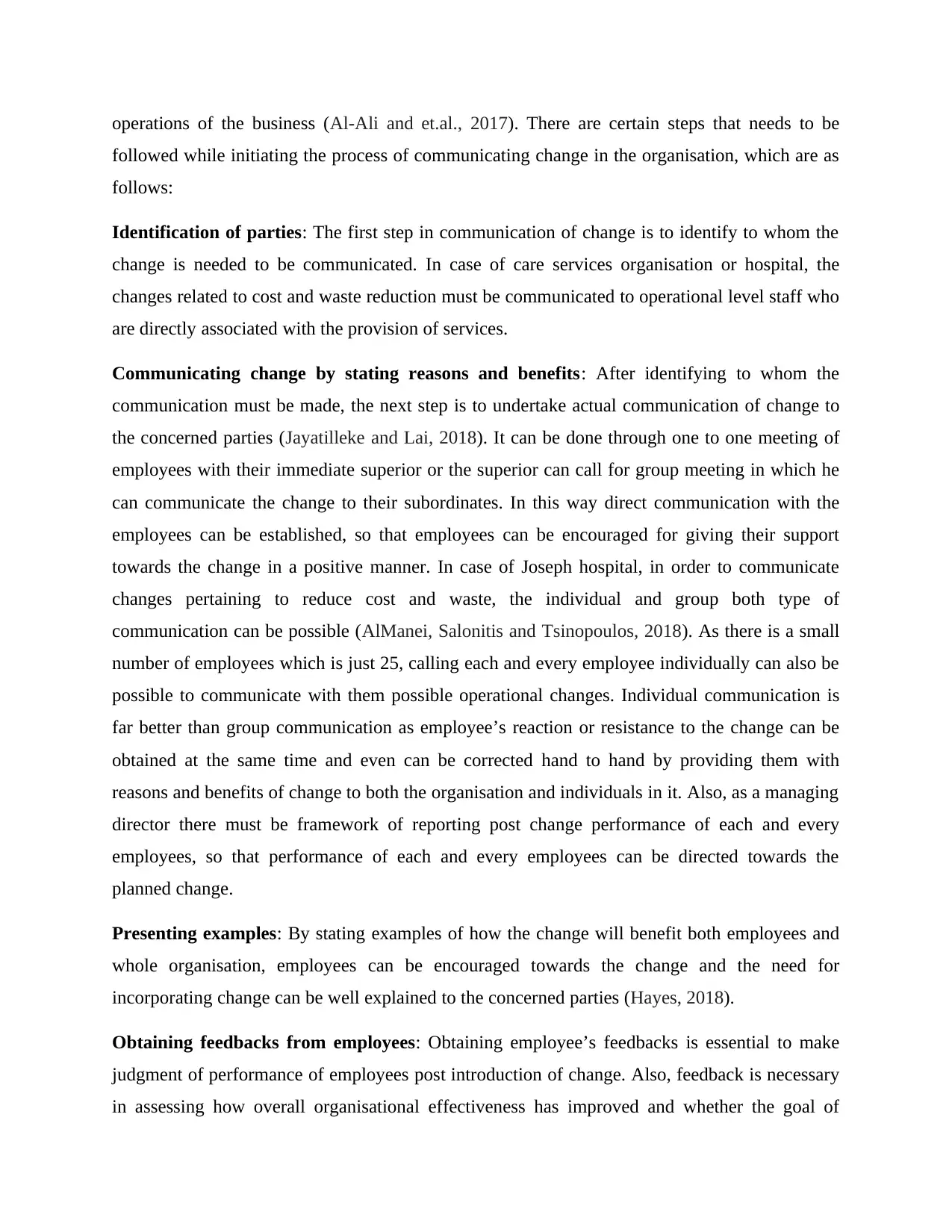
operations of the business (Al-Ali and et.al., 2017). There are certain steps that needs to be
followed while initiating the process of communicating change in the organisation, which are as
follows:
Identification of parties: The first step in communication of change is to identify to whom the
change is needed to be communicated. In case of care services organisation or hospital, the
changes related to cost and waste reduction must be communicated to operational level staff who
are directly associated with the provision of services.
Communicating change by stating reasons and benefits: After identifying to whom the
communication must be made, the next step is to undertake actual communication of change to
the concerned parties (Jayatilleke and Lai, 2018). It can be done through one to one meeting of
employees with their immediate superior or the superior can call for group meeting in which he
can communicate the change to their subordinates. In this way direct communication with the
employees can be established, so that employees can be encouraged for giving their support
towards the change in a positive manner. In case of Joseph hospital, in order to communicate
changes pertaining to reduce cost and waste, the individual and group both type of
communication can be possible (AlManei, Salonitis and Tsinopoulos, 2018). As there is a small
number of employees which is just 25, calling each and every employee individually can also be
possible to communicate with them possible operational changes. Individual communication is
far better than group communication as employee’s reaction or resistance to the change can be
obtained at the same time and even can be corrected hand to hand by providing them with
reasons and benefits of change to both the organisation and individuals in it. Also, as a managing
director there must be framework of reporting post change performance of each and every
employees, so that performance of each and every employees can be directed towards the
planned change.
Presenting examples: By stating examples of how the change will benefit both employees and
whole organisation, employees can be encouraged towards the change and the need for
incorporating change can be well explained to the concerned parties (Hayes, 2018).
Obtaining feedbacks from employees: Obtaining employee’s feedbacks is essential to make
judgment of performance of employees post introduction of change. Also, feedback is necessary
in assessing how overall organisational effectiveness has improved and whether the goal of
followed while initiating the process of communicating change in the organisation, which are as
follows:
Identification of parties: The first step in communication of change is to identify to whom the
change is needed to be communicated. In case of care services organisation or hospital, the
changes related to cost and waste reduction must be communicated to operational level staff who
are directly associated with the provision of services.
Communicating change by stating reasons and benefits: After identifying to whom the
communication must be made, the next step is to undertake actual communication of change to
the concerned parties (Jayatilleke and Lai, 2018). It can be done through one to one meeting of
employees with their immediate superior or the superior can call for group meeting in which he
can communicate the change to their subordinates. In this way direct communication with the
employees can be established, so that employees can be encouraged for giving their support
towards the change in a positive manner. In case of Joseph hospital, in order to communicate
changes pertaining to reduce cost and waste, the individual and group both type of
communication can be possible (AlManei, Salonitis and Tsinopoulos, 2018). As there is a small
number of employees which is just 25, calling each and every employee individually can also be
possible to communicate with them possible operational changes. Individual communication is
far better than group communication as employee’s reaction or resistance to the change can be
obtained at the same time and even can be corrected hand to hand by providing them with
reasons and benefits of change to both the organisation and individuals in it. Also, as a managing
director there must be framework of reporting post change performance of each and every
employees, so that performance of each and every employees can be directed towards the
planned change.
Presenting examples: By stating examples of how the change will benefit both employees and
whole organisation, employees can be encouraged towards the change and the need for
incorporating change can be well explained to the concerned parties (Hayes, 2018).
Obtaining feedbacks from employees: Obtaining employee’s feedbacks is essential to make
judgment of performance of employees post introduction of change. Also, feedback is necessary
in assessing how overall organisational effectiveness has improved and whether the goal of
Paraphrase This Document
Need a fresh take? Get an instant paraphrase of this document with our AI Paraphraser
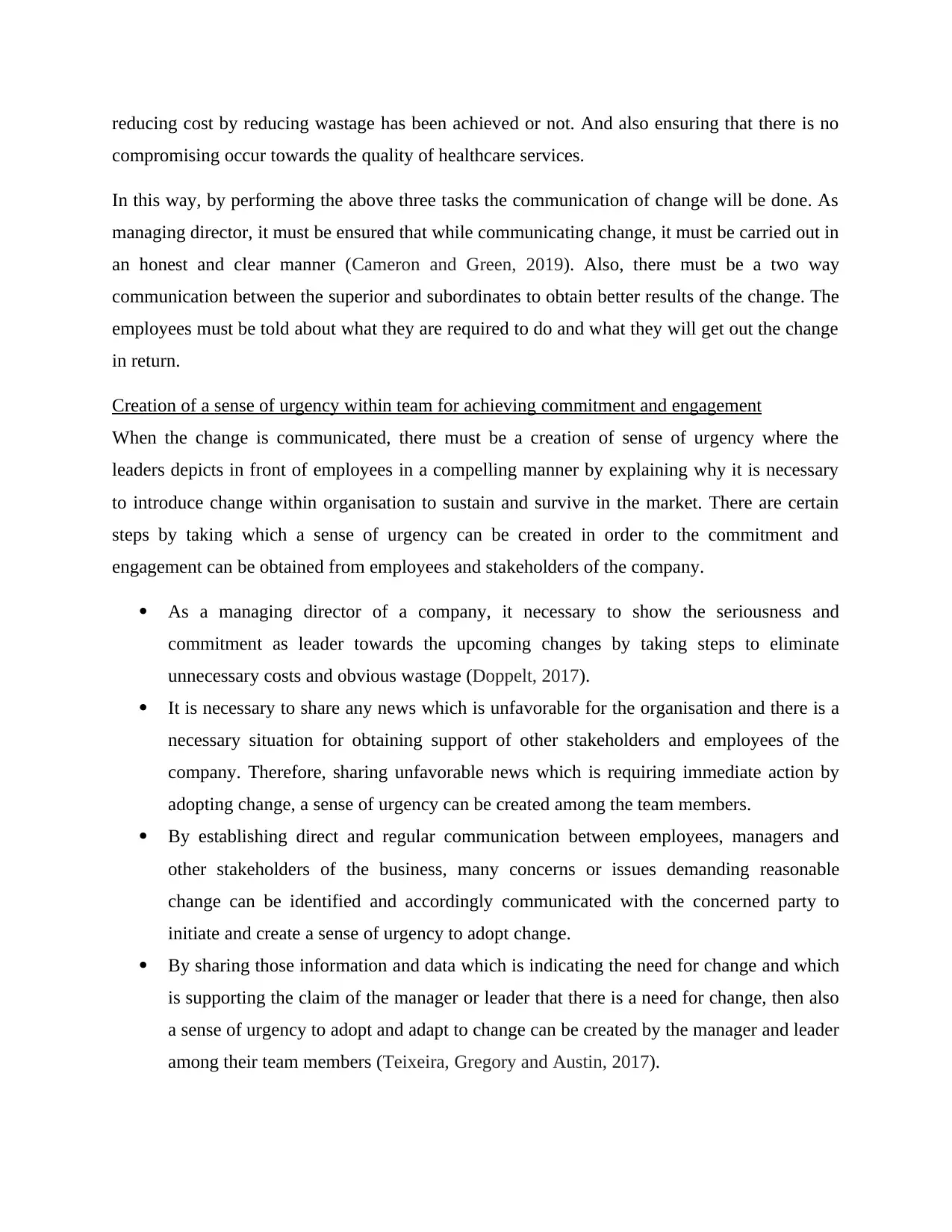
reducing cost by reducing wastage has been achieved or not. And also ensuring that there is no
compromising occur towards the quality of healthcare services.
In this way, by performing the above three tasks the communication of change will be done. As
managing director, it must be ensured that while communicating change, it must be carried out in
an honest and clear manner (Cameron and Green, 2019). Also, there must be a two way
communication between the superior and subordinates to obtain better results of the change. The
employees must be told about what they are required to do and what they will get out the change
in return.
Creation of a sense of urgency within team for achieving commitment and engagement
When the change is communicated, there must be a creation of sense of urgency where the
leaders depicts in front of employees in a compelling manner by explaining why it is necessary
to introduce change within organisation to sustain and survive in the market. There are certain
steps by taking which a sense of urgency can be created in order to the commitment and
engagement can be obtained from employees and stakeholders of the company.
As a managing director of a company, it necessary to show the seriousness and
commitment as leader towards the upcoming changes by taking steps to eliminate
unnecessary costs and obvious wastage (Doppelt, 2017).
It is necessary to share any news which is unfavorable for the organisation and there is a
necessary situation for obtaining support of other stakeholders and employees of the
company. Therefore, sharing unfavorable news which is requiring immediate action by
adopting change, a sense of urgency can be created among the team members.
By establishing direct and regular communication between employees, managers and
other stakeholders of the business, many concerns or issues demanding reasonable
change can be identified and accordingly communicated with the concerned party to
initiate and create a sense of urgency to adopt change.
By sharing those information and data which is indicating the need for change and which
is supporting the claim of the manager or leader that there is a need for change, then also
a sense of urgency to adopt and adapt to change can be created by the manager and leader
among their team members (Teixeira, Gregory and Austin, 2017).
compromising occur towards the quality of healthcare services.
In this way, by performing the above three tasks the communication of change will be done. As
managing director, it must be ensured that while communicating change, it must be carried out in
an honest and clear manner (Cameron and Green, 2019). Also, there must be a two way
communication between the superior and subordinates to obtain better results of the change. The
employees must be told about what they are required to do and what they will get out the change
in return.
Creation of a sense of urgency within team for achieving commitment and engagement
When the change is communicated, there must be a creation of sense of urgency where the
leaders depicts in front of employees in a compelling manner by explaining why it is necessary
to introduce change within organisation to sustain and survive in the market. There are certain
steps by taking which a sense of urgency can be created in order to the commitment and
engagement can be obtained from employees and stakeholders of the company.
As a managing director of a company, it necessary to show the seriousness and
commitment as leader towards the upcoming changes by taking steps to eliminate
unnecessary costs and obvious wastage (Doppelt, 2017).
It is necessary to share any news which is unfavorable for the organisation and there is a
necessary situation for obtaining support of other stakeholders and employees of the
company. Therefore, sharing unfavorable news which is requiring immediate action by
adopting change, a sense of urgency can be created among the team members.
By establishing direct and regular communication between employees, managers and
other stakeholders of the business, many concerns or issues demanding reasonable
change can be identified and accordingly communicated with the concerned party to
initiate and create a sense of urgency to adopt change.
By sharing those information and data which is indicating the need for change and which
is supporting the claim of the manager or leader that there is a need for change, then also
a sense of urgency to adopt and adapt to change can be created by the manager and leader
among their team members (Teixeira, Gregory and Austin, 2017).
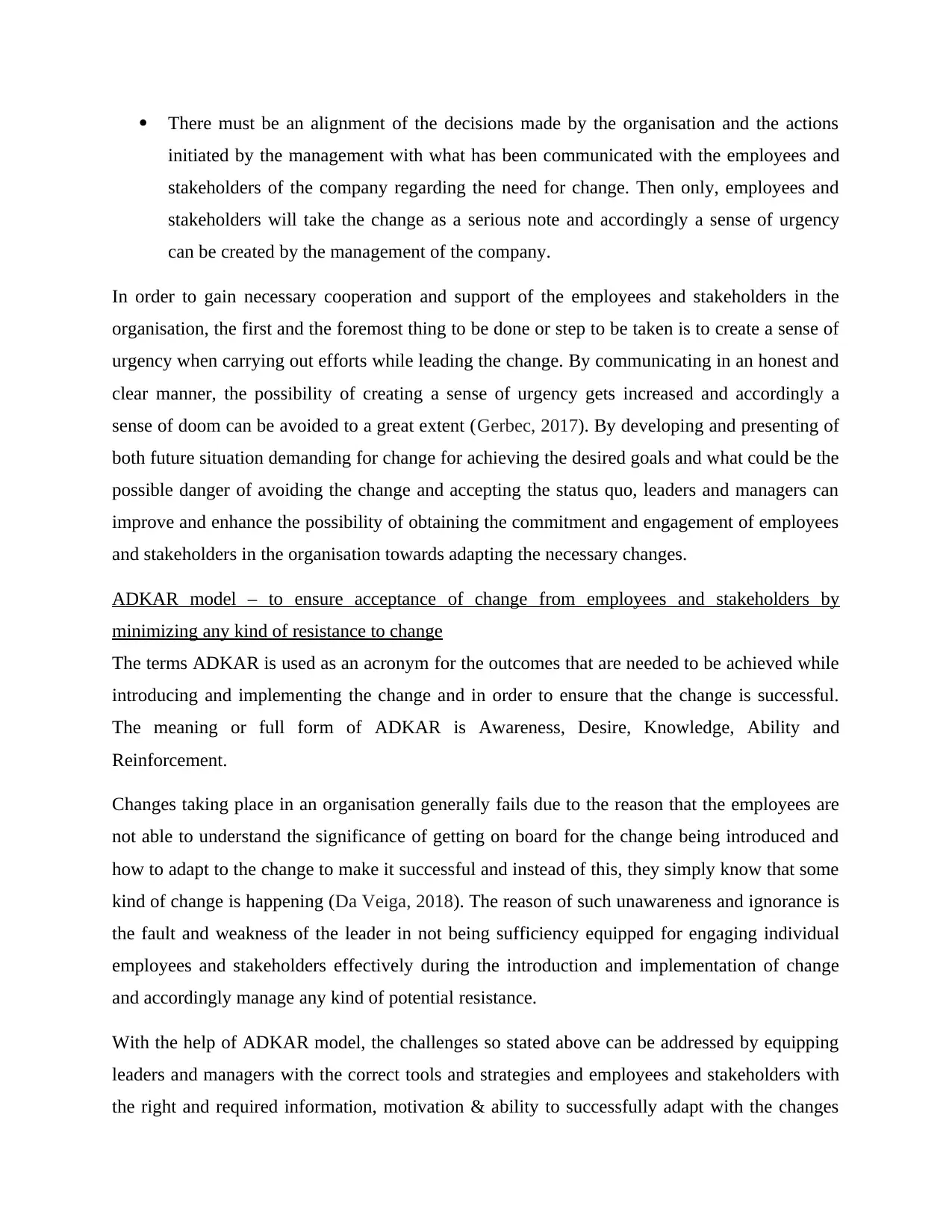
There must be an alignment of the decisions made by the organisation and the actions
initiated by the management with what has been communicated with the employees and
stakeholders of the company regarding the need for change. Then only, employees and
stakeholders will take the change as a serious note and accordingly a sense of urgency
can be created by the management of the company.
In order to gain necessary cooperation and support of the employees and stakeholders in the
organisation, the first and the foremost thing to be done or step to be taken is to create a sense of
urgency when carrying out efforts while leading the change. By communicating in an honest and
clear manner, the possibility of creating a sense of urgency gets increased and accordingly a
sense of doom can be avoided to a great extent (Gerbec, 2017). By developing and presenting of
both future situation demanding for change for achieving the desired goals and what could be the
possible danger of avoiding the change and accepting the status quo, leaders and managers can
improve and enhance the possibility of obtaining the commitment and engagement of employees
and stakeholders in the organisation towards adapting the necessary changes.
ADKAR model – to ensure acceptance of change from employees and stakeholders by
minimizing any kind of resistance to change
The terms ADKAR is used as an acronym for the outcomes that are needed to be achieved while
introducing and implementing the change and in order to ensure that the change is successful.
The meaning or full form of ADKAR is Awareness, Desire, Knowledge, Ability and
Reinforcement.
Changes taking place in an organisation generally fails due to the reason that the employees are
not able to understand the significance of getting on board for the change being introduced and
how to adapt to the change to make it successful and instead of this, they simply know that some
kind of change is happening (Da Veiga, 2018). The reason of such unawareness and ignorance is
the fault and weakness of the leader in not being sufficiency equipped for engaging individual
employees and stakeholders effectively during the introduction and implementation of change
and accordingly manage any kind of potential resistance.
With the help of ADKAR model, the challenges so stated above can be addressed by equipping
leaders and managers with the correct tools and strategies and employees and stakeholders with
the right and required information, motivation & ability to successfully adapt with the changes
initiated by the management with what has been communicated with the employees and
stakeholders of the company regarding the need for change. Then only, employees and
stakeholders will take the change as a serious note and accordingly a sense of urgency
can be created by the management of the company.
In order to gain necessary cooperation and support of the employees and stakeholders in the
organisation, the first and the foremost thing to be done or step to be taken is to create a sense of
urgency when carrying out efforts while leading the change. By communicating in an honest and
clear manner, the possibility of creating a sense of urgency gets increased and accordingly a
sense of doom can be avoided to a great extent (Gerbec, 2017). By developing and presenting of
both future situation demanding for change for achieving the desired goals and what could be the
possible danger of avoiding the change and accepting the status quo, leaders and managers can
improve and enhance the possibility of obtaining the commitment and engagement of employees
and stakeholders in the organisation towards adapting the necessary changes.
ADKAR model – to ensure acceptance of change from employees and stakeholders by
minimizing any kind of resistance to change
The terms ADKAR is used as an acronym for the outcomes that are needed to be achieved while
introducing and implementing the change and in order to ensure that the change is successful.
The meaning or full form of ADKAR is Awareness, Desire, Knowledge, Ability and
Reinforcement.
Changes taking place in an organisation generally fails due to the reason that the employees are
not able to understand the significance of getting on board for the change being introduced and
how to adapt to the change to make it successful and instead of this, they simply know that some
kind of change is happening (Da Veiga, 2018). The reason of such unawareness and ignorance is
the fault and weakness of the leader in not being sufficiency equipped for engaging individual
employees and stakeholders effectively during the introduction and implementation of change
and accordingly manage any kind of potential resistance.
With the help of ADKAR model, the challenges so stated above can be addressed by equipping
leaders and managers with the correct tools and strategies and employees and stakeholders with
the right and required information, motivation & ability to successfully adapt with the changes
⊘ This is a preview!⊘
Do you want full access?
Subscribe today to unlock all pages.

Trusted by 1+ million students worldwide
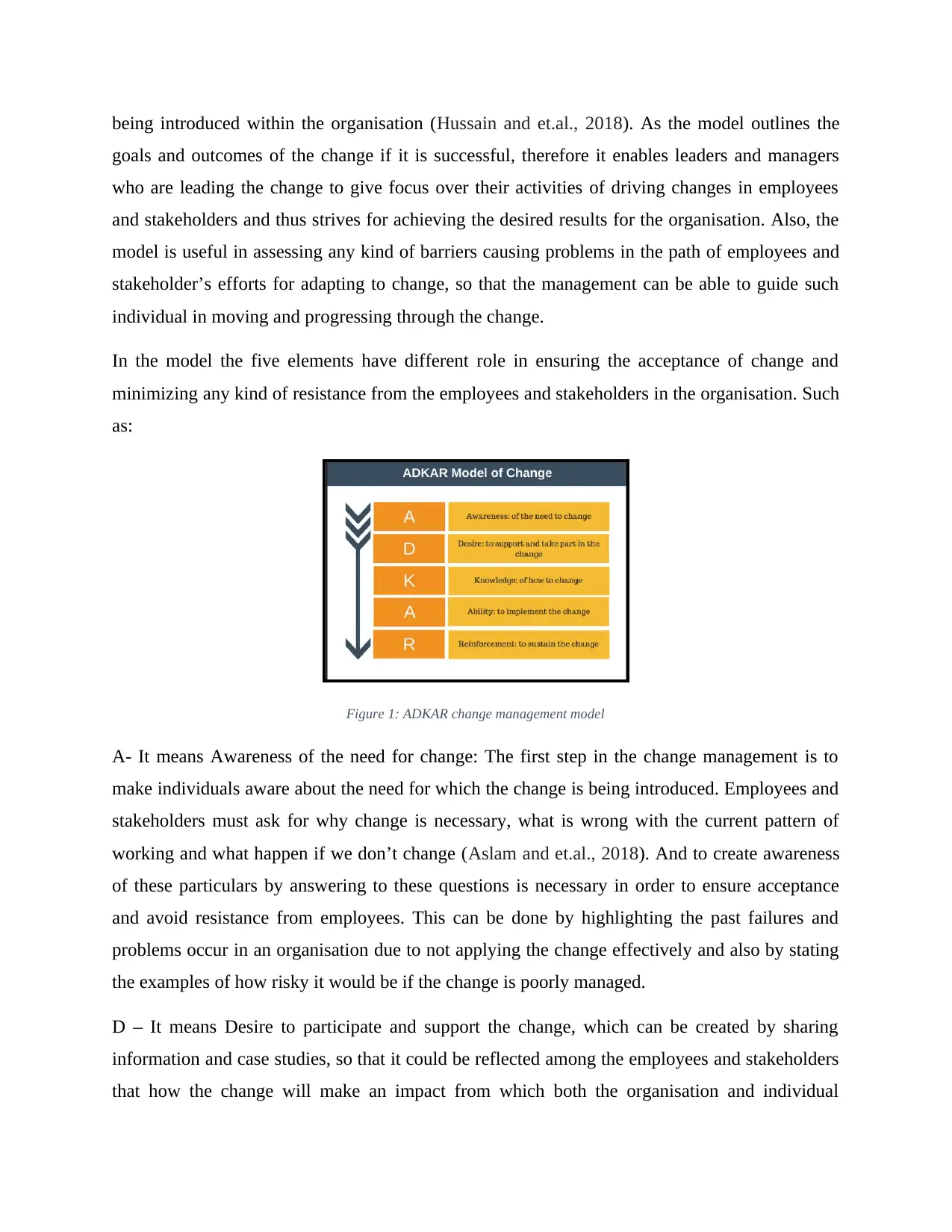
being introduced within the organisation (Hussain and et.al., 2018). As the model outlines the
goals and outcomes of the change if it is successful, therefore it enables leaders and managers
who are leading the change to give focus over their activities of driving changes in employees
and stakeholders and thus strives for achieving the desired results for the organisation. Also, the
model is useful in assessing any kind of barriers causing problems in the path of employees and
stakeholder’s efforts for adapting to change, so that the management can be able to guide such
individual in moving and progressing through the change.
In the model the five elements have different role in ensuring the acceptance of change and
minimizing any kind of resistance from the employees and stakeholders in the organisation. Such
as:
Figure 1: ADKAR change management model
A- It means Awareness of the need for change: The first step in the change management is to
make individuals aware about the need for which the change is being introduced. Employees and
stakeholders must ask for why change is necessary, what is wrong with the current pattern of
working and what happen if we don’t change (Aslam and et.al., 2018). And to create awareness
of these particulars by answering to these questions is necessary in order to ensure acceptance
and avoid resistance from employees. This can be done by highlighting the past failures and
problems occur in an organisation due to not applying the change effectively and also by stating
the examples of how risky it would be if the change is poorly managed.
D – It means Desire to participate and support the change, which can be created by sharing
information and case studies, so that it could be reflected among the employees and stakeholders
that how the change will make an impact from which both the organisation and individual
goals and outcomes of the change if it is successful, therefore it enables leaders and managers
who are leading the change to give focus over their activities of driving changes in employees
and stakeholders and thus strives for achieving the desired results for the organisation. Also, the
model is useful in assessing any kind of barriers causing problems in the path of employees and
stakeholder’s efforts for adapting to change, so that the management can be able to guide such
individual in moving and progressing through the change.
In the model the five elements have different role in ensuring the acceptance of change and
minimizing any kind of resistance from the employees and stakeholders in the organisation. Such
as:
Figure 1: ADKAR change management model
A- It means Awareness of the need for change: The first step in the change management is to
make individuals aware about the need for which the change is being introduced. Employees and
stakeholders must ask for why change is necessary, what is wrong with the current pattern of
working and what happen if we don’t change (Aslam and et.al., 2018). And to create awareness
of these particulars by answering to these questions is necessary in order to ensure acceptance
and avoid resistance from employees. This can be done by highlighting the past failures and
problems occur in an organisation due to not applying the change effectively and also by stating
the examples of how risky it would be if the change is poorly managed.
D – It means Desire to participate and support the change, which can be created by sharing
information and case studies, so that it could be reflected among the employees and stakeholders
that how the change will make an impact from which both the organisation and individual
Paraphrase This Document
Need a fresh take? Get an instant paraphrase of this document with our AI Paraphraser
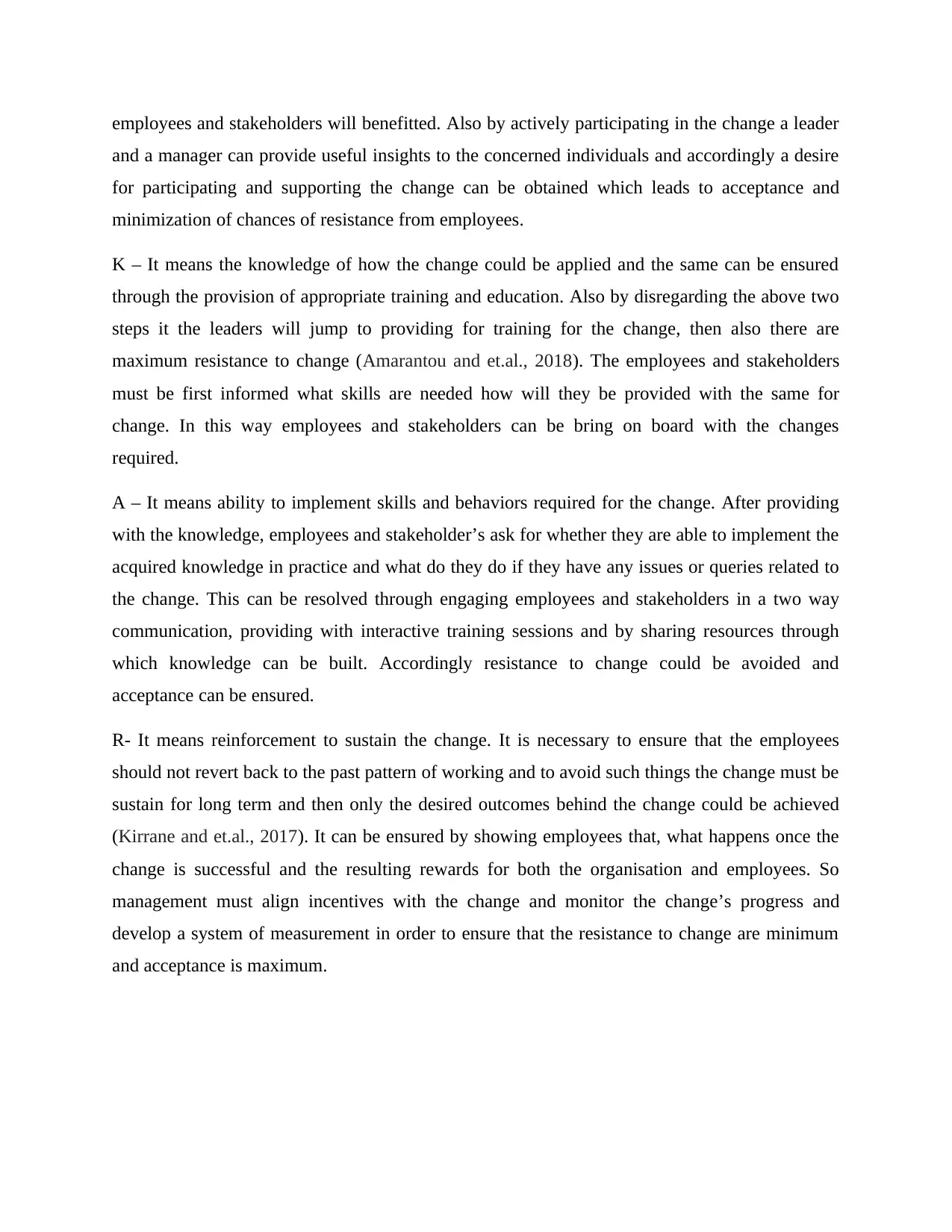
employees and stakeholders will benefitted. Also by actively participating in the change a leader
and a manager can provide useful insights to the concerned individuals and accordingly a desire
for participating and supporting the change can be obtained which leads to acceptance and
minimization of chances of resistance from employees.
K – It means the knowledge of how the change could be applied and the same can be ensured
through the provision of appropriate training and education. Also by disregarding the above two
steps it the leaders will jump to providing for training for the change, then also there are
maximum resistance to change (Amarantou and et.al., 2018). The employees and stakeholders
must be first informed what skills are needed how will they be provided with the same for
change. In this way employees and stakeholders can be bring on board with the changes
required.
A – It means ability to implement skills and behaviors required for the change. After providing
with the knowledge, employees and stakeholder’s ask for whether they are able to implement the
acquired knowledge in practice and what do they do if they have any issues or queries related to
the change. This can be resolved through engaging employees and stakeholders in a two way
communication, providing with interactive training sessions and by sharing resources through
which knowledge can be built. Accordingly resistance to change could be avoided and
acceptance can be ensured.
R- It means reinforcement to sustain the change. It is necessary to ensure that the employees
should not revert back to the past pattern of working and to avoid such things the change must be
sustain for long term and then only the desired outcomes behind the change could be achieved
(Kirrane and et.al., 2017). It can be ensured by showing employees that, what happens once the
change is successful and the resulting rewards for both the organisation and employees. So
management must align incentives with the change and monitor the change’s progress and
develop a system of measurement in order to ensure that the resistance to change are minimum
and acceptance is maximum.
and a manager can provide useful insights to the concerned individuals and accordingly a desire
for participating and supporting the change can be obtained which leads to acceptance and
minimization of chances of resistance from employees.
K – It means the knowledge of how the change could be applied and the same can be ensured
through the provision of appropriate training and education. Also by disregarding the above two
steps it the leaders will jump to providing for training for the change, then also there are
maximum resistance to change (Amarantou and et.al., 2018). The employees and stakeholders
must be first informed what skills are needed how will they be provided with the same for
change. In this way employees and stakeholders can be bring on board with the changes
required.
A – It means ability to implement skills and behaviors required for the change. After providing
with the knowledge, employees and stakeholder’s ask for whether they are able to implement the
acquired knowledge in practice and what do they do if they have any issues or queries related to
the change. This can be resolved through engaging employees and stakeholders in a two way
communication, providing with interactive training sessions and by sharing resources through
which knowledge can be built. Accordingly resistance to change could be avoided and
acceptance can be ensured.
R- It means reinforcement to sustain the change. It is necessary to ensure that the employees
should not revert back to the past pattern of working and to avoid such things the change must be
sustain for long term and then only the desired outcomes behind the change could be achieved
(Kirrane and et.al., 2017). It can be ensured by showing employees that, what happens once the
change is successful and the resulting rewards for both the organisation and employees. So
management must align incentives with the change and monitor the change’s progress and
develop a system of measurement in order to ensure that the resistance to change are minimum
and acceptance is maximum.
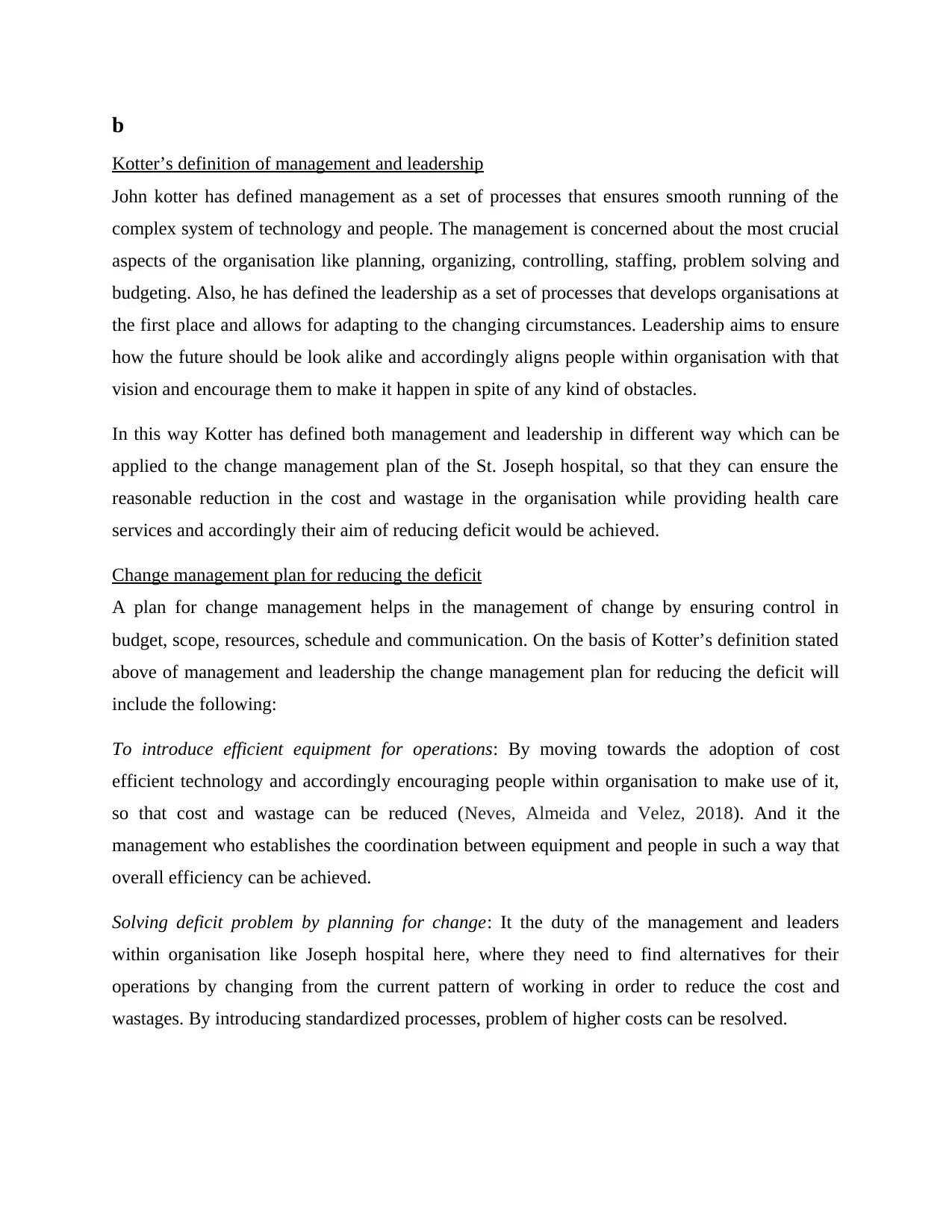
b
Kotter’s definition of management and leadership
John kotter has defined management as a set of processes that ensures smooth running of the
complex system of technology and people. The management is concerned about the most crucial
aspects of the organisation like planning, organizing, controlling, staffing, problem solving and
budgeting. Also, he has defined the leadership as a set of processes that develops organisations at
the first place and allows for adapting to the changing circumstances. Leadership aims to ensure
how the future should be look alike and accordingly aligns people within organisation with that
vision and encourage them to make it happen in spite of any kind of obstacles.
In this way Kotter has defined both management and leadership in different way which can be
applied to the change management plan of the St. Joseph hospital, so that they can ensure the
reasonable reduction in the cost and wastage in the organisation while providing health care
services and accordingly their aim of reducing deficit would be achieved.
Change management plan for reducing the deficit
A plan for change management helps in the management of change by ensuring control in
budget, scope, resources, schedule and communication. On the basis of Kotter’s definition stated
above of management and leadership the change management plan for reducing the deficit will
include the following:
To introduce efficient equipment for operations: By moving towards the adoption of cost
efficient technology and accordingly encouraging people within organisation to make use of it,
so that cost and wastage can be reduced (Neves, Almeida and Velez, 2018). And it the
management who establishes the coordination between equipment and people in such a way that
overall efficiency can be achieved.
Solving deficit problem by planning for change: It the duty of the management and leaders
within organisation like Joseph hospital here, where they need to find alternatives for their
operations by changing from the current pattern of working in order to reduce the cost and
wastages. By introducing standardized processes, problem of higher costs can be resolved.
Kotter’s definition of management and leadership
John kotter has defined management as a set of processes that ensures smooth running of the
complex system of technology and people. The management is concerned about the most crucial
aspects of the organisation like planning, organizing, controlling, staffing, problem solving and
budgeting. Also, he has defined the leadership as a set of processes that develops organisations at
the first place and allows for adapting to the changing circumstances. Leadership aims to ensure
how the future should be look alike and accordingly aligns people within organisation with that
vision and encourage them to make it happen in spite of any kind of obstacles.
In this way Kotter has defined both management and leadership in different way which can be
applied to the change management plan of the St. Joseph hospital, so that they can ensure the
reasonable reduction in the cost and wastage in the organisation while providing health care
services and accordingly their aim of reducing deficit would be achieved.
Change management plan for reducing the deficit
A plan for change management helps in the management of change by ensuring control in
budget, scope, resources, schedule and communication. On the basis of Kotter’s definition stated
above of management and leadership the change management plan for reducing the deficit will
include the following:
To introduce efficient equipment for operations: By moving towards the adoption of cost
efficient technology and accordingly encouraging people within organisation to make use of it,
so that cost and wastage can be reduced (Neves, Almeida and Velez, 2018). And it the
management who establishes the coordination between equipment and people in such a way that
overall efficiency can be achieved.
Solving deficit problem by planning for change: It the duty of the management and leaders
within organisation like Joseph hospital here, where they need to find alternatives for their
operations by changing from the current pattern of working in order to reduce the cost and
wastages. By introducing standardized processes, problem of higher costs can be resolved.
⊘ This is a preview!⊘
Do you want full access?
Subscribe today to unlock all pages.

Trusted by 1+ million students worldwide
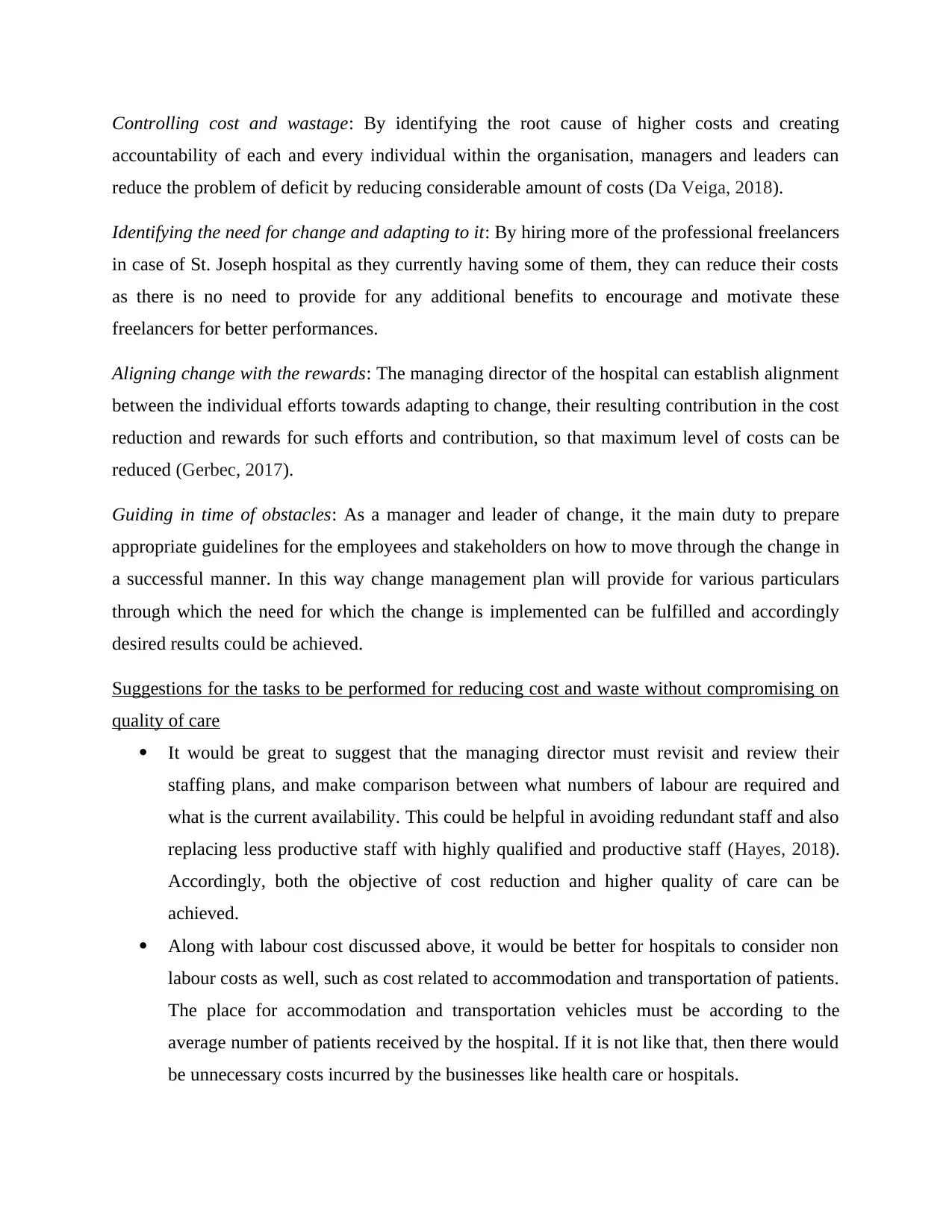
Controlling cost and wastage: By identifying the root cause of higher costs and creating
accountability of each and every individual within the organisation, managers and leaders can
reduce the problem of deficit by reducing considerable amount of costs (Da Veiga, 2018).
Identifying the need for change and adapting to it: By hiring more of the professional freelancers
in case of St. Joseph hospital as they currently having some of them, they can reduce their costs
as there is no need to provide for any additional benefits to encourage and motivate these
freelancers for better performances.
Aligning change with the rewards: The managing director of the hospital can establish alignment
between the individual efforts towards adapting to change, their resulting contribution in the cost
reduction and rewards for such efforts and contribution, so that maximum level of costs can be
reduced (Gerbec, 2017).
Guiding in time of obstacles: As a manager and leader of change, it the main duty to prepare
appropriate guidelines for the employees and stakeholders on how to move through the change in
a successful manner. In this way change management plan will provide for various particulars
through which the need for which the change is implemented can be fulfilled and accordingly
desired results could be achieved.
Suggestions for the tasks to be performed for reducing cost and waste without compromising on
quality of care
It would be great to suggest that the managing director must revisit and review their
staffing plans, and make comparison between what numbers of labour are required and
what is the current availability. This could be helpful in avoiding redundant staff and also
replacing less productive staff with highly qualified and productive staff (Hayes, 2018).
Accordingly, both the objective of cost reduction and higher quality of care can be
achieved.
Along with labour cost discussed above, it would be better for hospitals to consider non
labour costs as well, such as cost related to accommodation and transportation of patients.
The place for accommodation and transportation vehicles must be according to the
average number of patients received by the hospital. If it is not like that, then there would
be unnecessary costs incurred by the businesses like health care or hospitals.
accountability of each and every individual within the organisation, managers and leaders can
reduce the problem of deficit by reducing considerable amount of costs (Da Veiga, 2018).
Identifying the need for change and adapting to it: By hiring more of the professional freelancers
in case of St. Joseph hospital as they currently having some of them, they can reduce their costs
as there is no need to provide for any additional benefits to encourage and motivate these
freelancers for better performances.
Aligning change with the rewards: The managing director of the hospital can establish alignment
between the individual efforts towards adapting to change, their resulting contribution in the cost
reduction and rewards for such efforts and contribution, so that maximum level of costs can be
reduced (Gerbec, 2017).
Guiding in time of obstacles: As a manager and leader of change, it the main duty to prepare
appropriate guidelines for the employees and stakeholders on how to move through the change in
a successful manner. In this way change management plan will provide for various particulars
through which the need for which the change is implemented can be fulfilled and accordingly
desired results could be achieved.
Suggestions for the tasks to be performed for reducing cost and waste without compromising on
quality of care
It would be great to suggest that the managing director must revisit and review their
staffing plans, and make comparison between what numbers of labour are required and
what is the current availability. This could be helpful in avoiding redundant staff and also
replacing less productive staff with highly qualified and productive staff (Hayes, 2018).
Accordingly, both the objective of cost reduction and higher quality of care can be
achieved.
Along with labour cost discussed above, it would be better for hospitals to consider non
labour costs as well, such as cost related to accommodation and transportation of patients.
The place for accommodation and transportation vehicles must be according to the
average number of patients received by the hospital. If it is not like that, then there would
be unnecessary costs incurred by the businesses like health care or hospitals.
Paraphrase This Document
Need a fresh take? Get an instant paraphrase of this document with our AI Paraphraser
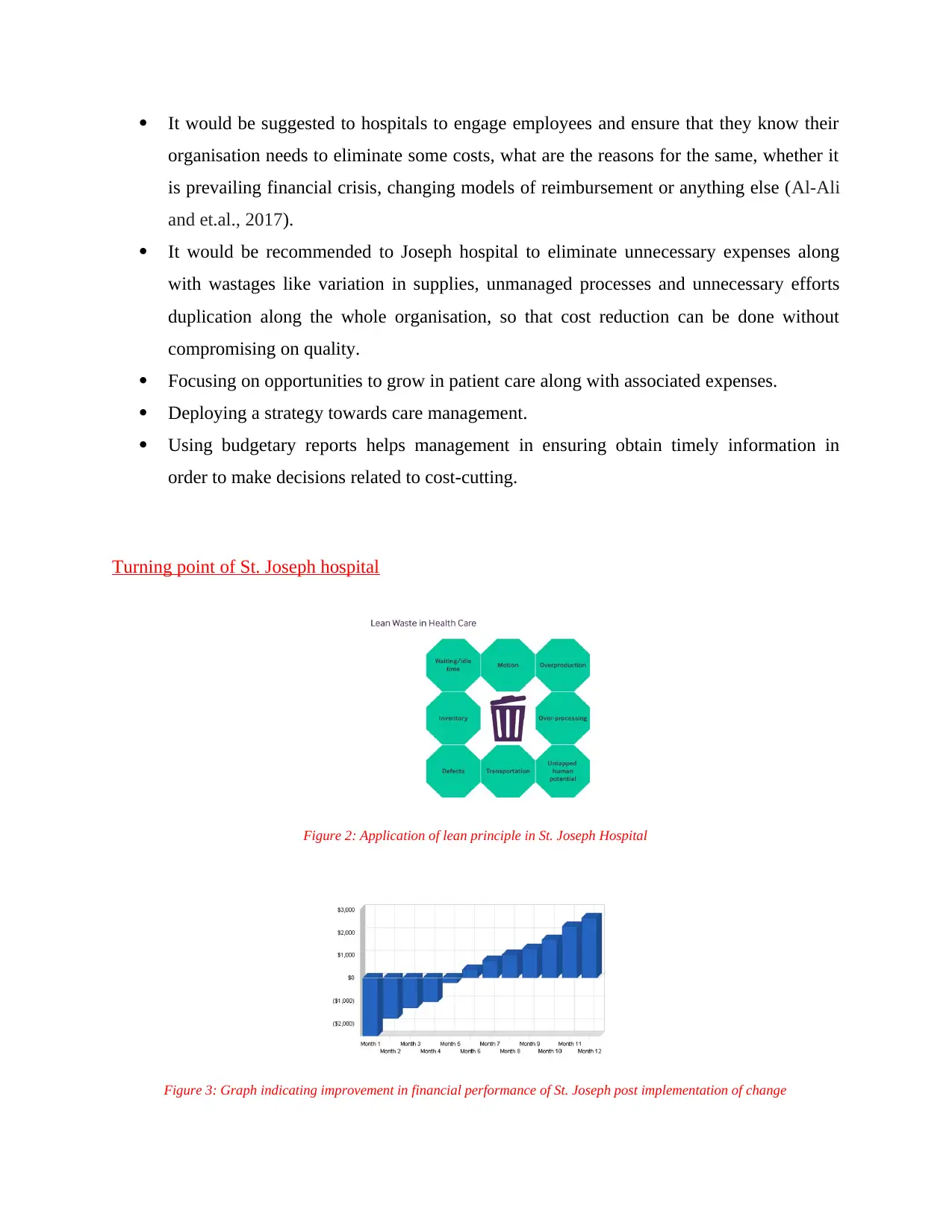
It would be suggested to hospitals to engage employees and ensure that they know their
organisation needs to eliminate some costs, what are the reasons for the same, whether it
is prevailing financial crisis, changing models of reimbursement or anything else (Al-Ali
and et.al., 2017).
It would be recommended to Joseph hospital to eliminate unnecessary expenses along
with wastages like variation in supplies, unmanaged processes and unnecessary efforts
duplication along the whole organisation, so that cost reduction can be done without
compromising on quality.
Focusing on opportunities to grow in patient care along with associated expenses.
Deploying a strategy towards care management.
Using budgetary reports helps management in ensuring obtain timely information in
order to make decisions related to cost-cutting.
Turning point of St. Joseph hospital
Figure 2: Application of lean principle in St. Joseph Hospital
Figure 3: Graph indicating improvement in financial performance of St. Joseph post implementation of change
organisation needs to eliminate some costs, what are the reasons for the same, whether it
is prevailing financial crisis, changing models of reimbursement or anything else (Al-Ali
and et.al., 2017).
It would be recommended to Joseph hospital to eliminate unnecessary expenses along
with wastages like variation in supplies, unmanaged processes and unnecessary efforts
duplication along the whole organisation, so that cost reduction can be done without
compromising on quality.
Focusing on opportunities to grow in patient care along with associated expenses.
Deploying a strategy towards care management.
Using budgetary reports helps management in ensuring obtain timely information in
order to make decisions related to cost-cutting.
Turning point of St. Joseph hospital
Figure 2: Application of lean principle in St. Joseph Hospital
Figure 3: Graph indicating improvement in financial performance of St. Joseph post implementation of change
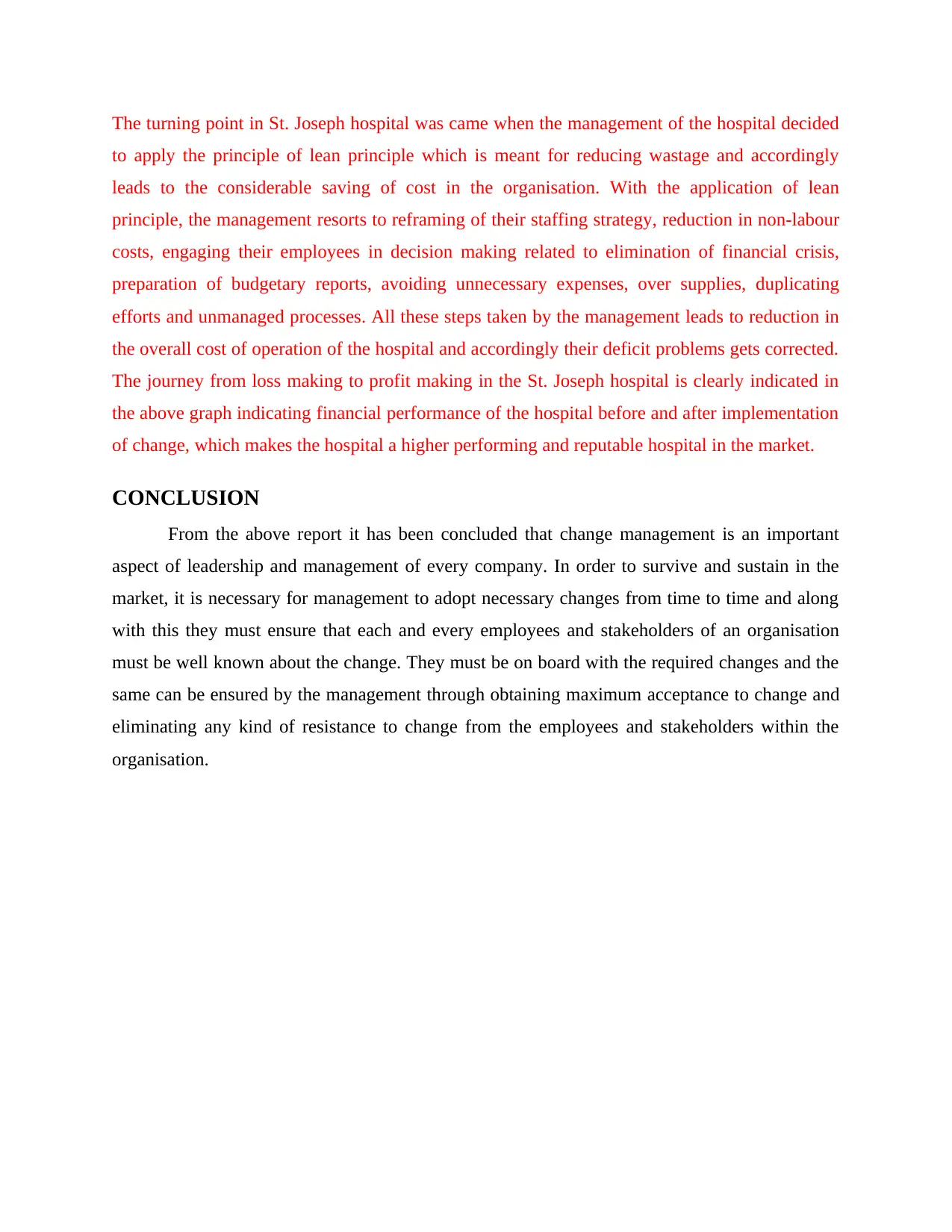
The turning point in St. Joseph hospital was came when the management of the hospital decided
to apply the principle of lean principle which is meant for reducing wastage and accordingly
leads to the considerable saving of cost in the organisation. With the application of lean
principle, the management resorts to reframing of their staffing strategy, reduction in non-labour
costs, engaging their employees in decision making related to elimination of financial crisis,
preparation of budgetary reports, avoiding unnecessary expenses, over supplies, duplicating
efforts and unmanaged processes. All these steps taken by the management leads to reduction in
the overall cost of operation of the hospital and accordingly their deficit problems gets corrected.
The journey from loss making to profit making in the St. Joseph hospital is clearly indicated in
the above graph indicating financial performance of the hospital before and after implementation
of change, which makes the hospital a higher performing and reputable hospital in the market.
CONCLUSION
From the above report it has been concluded that change management is an important
aspect of leadership and management of every company. In order to survive and sustain in the
market, it is necessary for management to adopt necessary changes from time to time and along
with this they must ensure that each and every employees and stakeholders of an organisation
must be well known about the change. They must be on board with the required changes and the
same can be ensured by the management through obtaining maximum acceptance to change and
eliminating any kind of resistance to change from the employees and stakeholders within the
organisation.
to apply the principle of lean principle which is meant for reducing wastage and accordingly
leads to the considerable saving of cost in the organisation. With the application of lean
principle, the management resorts to reframing of their staffing strategy, reduction in non-labour
costs, engaging their employees in decision making related to elimination of financial crisis,
preparation of budgetary reports, avoiding unnecessary expenses, over supplies, duplicating
efforts and unmanaged processes. All these steps taken by the management leads to reduction in
the overall cost of operation of the hospital and accordingly their deficit problems gets corrected.
The journey from loss making to profit making in the St. Joseph hospital is clearly indicated in
the above graph indicating financial performance of the hospital before and after implementation
of change, which makes the hospital a higher performing and reputable hospital in the market.
CONCLUSION
From the above report it has been concluded that change management is an important
aspect of leadership and management of every company. In order to survive and sustain in the
market, it is necessary for management to adopt necessary changes from time to time and along
with this they must ensure that each and every employees and stakeholders of an organisation
must be well known about the change. They must be on board with the required changes and the
same can be ensured by the management through obtaining maximum acceptance to change and
eliminating any kind of resistance to change from the employees and stakeholders within the
organisation.
⊘ This is a preview!⊘
Do you want full access?
Subscribe today to unlock all pages.

Trusted by 1+ million students worldwide
1 out of 14
Related Documents
Your All-in-One AI-Powered Toolkit for Academic Success.
+13062052269
info@desklib.com
Available 24*7 on WhatsApp / Email
![[object Object]](/_next/static/media/star-bottom.7253800d.svg)
Unlock your academic potential
Copyright © 2020–2025 A2Z Services. All Rights Reserved. Developed and managed by ZUCOL.





